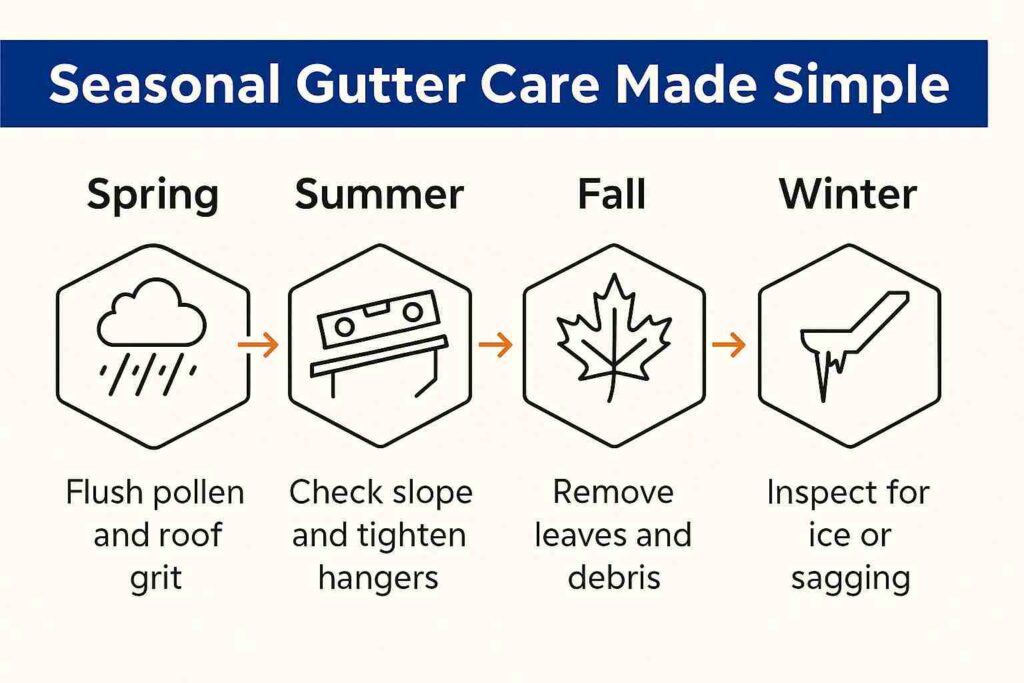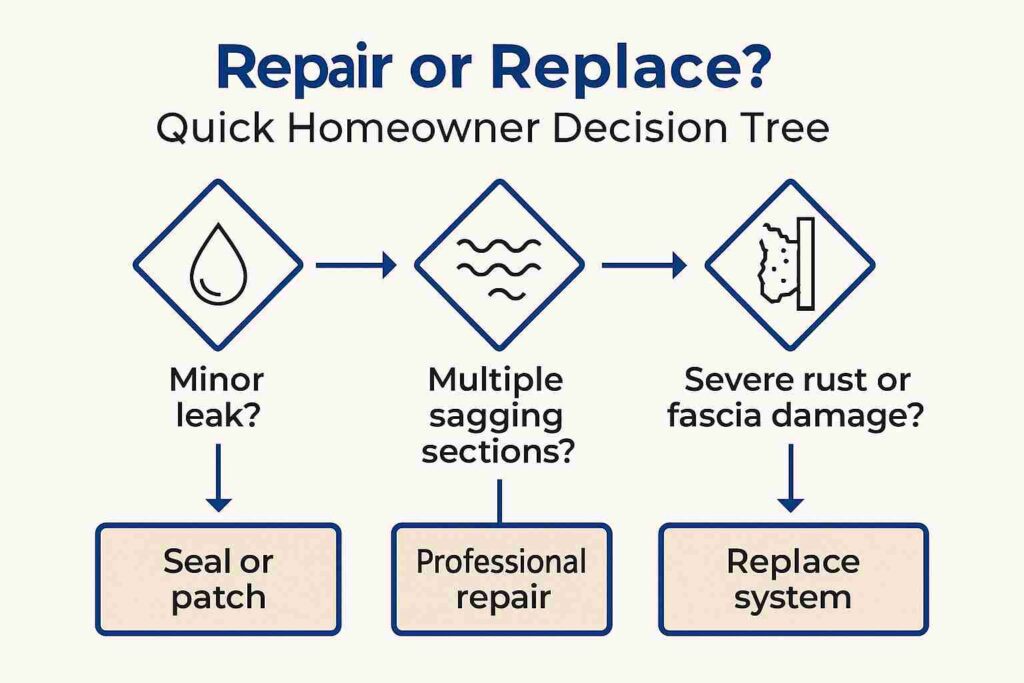Expert Advice from Priority Roofing
Your home’s gutters might not get much attention until they stop working. When that happens, you’ll notice water spilling over the edges, damp patches on walls, or even pooling near the foundation. Left unchecked, those minor warning signs can turn into roof leaks, wood rot, and severe structural damage.
At Priority Roofing, we’ve helped homeowners and businesses across the U.S. keep their roofing and gutter systems in top shape through every kind of weather, from Texas hail and Midwest snow to Florida rain and desert dust.
This guide breaks down everything you need to know about cleaning, repairing, and replacing gutters, whether you’re a DIY homeowner or looking for professional help near you.
How to Clean Gutters
Gutters fill with leaves, grit, and dirt throughout the year. When that material builds up, water can overflow and run down the siding or pool near the foundation. Cleaning gutters on a routine schedule keeps water moving the way it should and protects your home from moisture damage.
This guide shows you how to clean gutters safely, what tools you need, and how to clear stubborn downspout clogs.
1. How Long Do Gutters Last and Why Regular Maintenance Matters
A well-installed gutter system can last 20 to 30 years on average, but only with consistent care.
Different materials hold up differently:
- Aluminum gutters: 20-25 years with light upkeep
- Vinyl gutters: 10-15 years, but prone to cracking in extreme heat or cold
- Copper gutters: 40-50 years, often chosen for high-end homes
No matter the type, all gutters need cleaning at least twice a year, spring and fall. That’s when pollen, seeds, and leaves are most likely to clog your drainage system.
Early signs your gutters need attention:
- Water overflowing during rainfall
- Peeling paint or rust along the edges
- Sagging or pulling away from the fascia boards
- Water stains or mildew near your home’s foundation
Taking action early is always cheaper than waiting until damage spreads to your roof or walls.
2. The 5 Most Common Gutter Problems Homeowners Face
1. Clogged or Overflowing Gutters
Over time, leaves, pine needles, and shingle grit build up, blocking water flow and causing gutters to overflow during storms.
2. Sagging or Detached Gutters
Heavy rain, ice, or debris can weigh gutters down, loosening hangers and breaking alignment.
3. Leaks and Rust
Metal gutters eventually corrode; vinyl seams dry out and crack. Even small leaks can lead to fascia rot.
4. Mold, Mildew, and Wood Rot
Trapped water is a breeding ground for mildew and can seep under your roof edge, damaging structural wood.
5. Foundation and Landscaping Erosion
When gutters can’t channel water properly, it can pool near your foundation, leading to costly basement and soil issues.
Pro tip: Walk around your home after a heavy rain. If you see water spilling from the gutters or pooling near the base, it’s time for maintenance.
3. Can I Repair My Own Gutters? (DIY Done Safely)
Many homeowners can handle small fixes on their own as long as they’re careful and know their limits.
Here’s what’s safe to do yourself:
- Cleaning out debris and flushing gutters with a hose
- Tightening loose hangers or screws
- Resealing joints with gutter sealant
- Patching small holes using metal flashing and caulk
What you’ll need:
- Ladder with stabilizer
- Rubber gloves, goggles, and sturdy shoes
- Garden hose
- Gutter scoop or trowel
- Sealant, metal snips, patch material, and screwdriver
Safety reminder: Never work alone or on a wet roof. If your gutters are more than one story up or near power lines, call a professional instead.
DIY work is helpful for light maintenance, but if your gutters are sagging, leaking heavily, or causing roof-edge damage, professional repair is a smarter move.
4. Can a Handyman Repair Gutters or Should I Call a Roofer?
A handyman can fix small issues like tightening hangers or resealing joints. But when the problem involves:
- Fascia rot
- Damaged roof flashing
- Persistent leaks along the roofline
…it’s time to call a roofing specialist.
At Priority Roofing, our team inspects the full roof-and-gutter system to catch the underlying issues that handymen often miss. We look at fascia boards, flashing, shingle runoff, and water drainage not just the gutter itself.
This full-system approach prevents repeat leaks and ensures long-term protection for your home.
5. How Much Does It Cost to Repair a Gutter?
Prices vary depending on material, roof height, and how severe the damage is. Here’s a realistic breakdown:
| Type of Repair | Average Cost Range | What’s Included |
| Sealing joints or cracks | $240 – $480 | Basic sealant and labor |
| Tightening or replacing hangers | $150 – $300 | Common after storms |
| Patching small holes | $200 – $400 | May require paint and priming |
| Sectional replacement | $500 – $1,000 | Includes rehang and leveling |
| Full replacement | $2,500 – $5,000 | Based on home size and material |
Average homeowner spends: around $350–$450 for minor gutter repair.
Remember if your gutters are older than 20 years, it’s often more cost-effective to replace than keep patching.
6. Step-by-Step Gutter Cleaning & Maintenance Guide
Cleaning your gutters doesn’t take fancy tools just patience and care.
Step 1: Set up your ladder safely and wear protective gear.
Step 2: Scoop out leaves, dirt, and debris.
Step 3: Rinse gutters with a hose to check for leaks or poor flow.
Step 4: Tighten brackets and reseal small gaps.
Step 5: Make sure water flows toward the downspout (a quarter-inch slope for every 10 feet).
Maintenance Frequency:
- Twice a year minimum: Spring (after pollen) and Fall (after leaves drop)
- More often if your property has tall trees, frequent storms, or heavy snow
Preventative Upgrades:
- Gutter guards or screens to limit debris
- Larger downspouts to handle heavy rain
- Seamless gutters for fewer leak points

7. When to Replace Your Gutters Instead of Repairing Them
Even the most durable gutters won’t last forever. If you notice these issues, replacement is the smarter option:
- Rust holes or cracks spreading across multiple sections
- Gutters constantly pulling away from the fascia
- Persistent overflow despite cleaning
- Water pooling near your home’s base
- Mold or foundation cracks inside your basement
When replacing gutters, it’s worth having your roofer inspect fascia boards and roof flashing to ensure a watertight installation.

8. Preventing Gutter Damage in Every Climate
Southern & Western U.S. (TX, AZ, NV):High UV exposure dries out sealant; check for cracks yearly.
Dust storms and heavy pollen require more frequent rinsing.
Midwest & Northern States (CO, IL, OH): Ice dams and freezing water can loosen hangers. Keep gutters clear before winter.
Coastal & Humid Regions (FL, SC, LA): Salt and humidity corrode metal faster. Wash with fresh water every few months.
Wherever you live, trim trees away from the roofline and inspect after every major storm.
9. Why Professional Gutter Inspections Save You Money
A professional inspection ensures your entire water drainage system, roof, flashing, fascia, and gutters work together.
Priority Roofing’s inspections include:
- Checking for leaks, slope issues, and weak brackets
- Examining roof edges and flashing for damage
- Assessing drainage efficiency after storms
- Providing a detailed repair or replacement plan
We also assist with storm damage insurance claims, ensuring homeowners get fair coverage for hail or wind-related gutter damage.
10. Call Priority Roofing Your Nationwide Roof & Gutter Experts
Whether you need a quick repair, full replacement, or just peace of mind, Priority Roofing has you covered.
We proudly serve 30+ locations nationwide, offering:
- Free roof and gutter inspections
- Professional gutter cleaning and sealing
- Seamless gutter replacement
- Roof-edge repair and flashing upgrades
Protect your home from the top down.
Schedule your complimentary gutter and roof inspection near you today with Priority Roofing, your trusted experts in keeping water where it belongs: away from your home.



